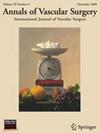保留胃下动脉灌注的医生改良型栅栏式血管内主动脉修补术和水凝胶线圈栅栏加固的疗效。
IF 1.4
4区 医学
Q3 PERIPHERAL VASCULAR DISEASE
引用次数: 0
摘要
导言:在腹主动脉血管内修复手术中,有时需要将远端密封区延伸至髂外动脉。由于髂支装置的使用取决于特定的解剖要求,因此这种装置的应用并不普遍。在此,我们提出了一种替代方法,即使用医生改良的带水凝胶线圈加固的AFX肢体(Endologix,Inc.,Irvine,CA,USA)来保留胃下动脉灌注:方法:在2022年10月至2023年10月期间,在单个中心接受医生改良的腹主动脉修补术以保留胃下动脉灌注的患者被纳入前瞻性研究。临床终点是技术成功,即通过创建的瘘口成功再通下胃动脉,且无 3c 型内漏。此外,还调查了随访期间下腹动脉的通畅情况和新出现的内漏情况:结果:总共有 15 名患者的 16 条胃下动脉通过该技术得到了保护。患者的平均年龄为 76.9 ± 10.4 岁。医生改良式腹主动脉瓣修复术的适应症为髂总动脉瘤(6 例)、胃下动脉瘤(3 例)、既往腹主动脉瓣修复术后 1b 型内漏的矫正(4 例)以及髂总动脉密封区不合适的腹主动脉瘤(3 例)。所有患者都被认为不适合使用市售的髂支装置。所有瘘管均使用水凝胶线圈加固。经医生改良的腹主动脉瓣修复技术成功率为100%。在随访期间(平均:11.6 个月),没有发生分支闭塞或 3c 型内漏:我们的初步经验表明,为保留下腹部动脉灌注而采用水凝胶线圈加固的医生改良式腹主动脉瓣修复术可能是将密封区延伸至髂外动脉的一种安全有效的选择。有必要进一步积累经验并确定可能出现的并发症,以探索扩大使用这种技术的潜力。本文章由计算机程序翻译,如有差异,请以英文原文为准。
Physician-Modified Fenestrated Endovascular Aortic Repair for the Preservation of Hypogastric Artery Perfusion and Efficacy of Hydrogel Coil Fenestration Reinforcement
Background
Extending the distal sealing zone into the external iliac artery is sometimes necessary during endovascular abdominal aortic repair. As the use of an iliac branch device is contingent upon certain anatomical requirements, the application of this device is not universal. Herein, we present an alternative method to preserve hypogastric artery perfusion using a physician-modified fenestrated (PMF) AFX limb (Endologix, Inc., Irvine, CA, USA) with hydrogel coil reinforcement.
Methods
Patients undergoing PMF endovascular abdominal aortic repair for the preservation of hypogastric artery perfusion between October 2022 and October 2023 at a single center were prospectively enrolled. The clinical endpoint was technical success, defined as successful revisualization of the hypogastric artery through the created fenestration and the absence of type 3c endoleaks. Furthermore, hypogastric artery patency and newly developed endoleaks were investigated during the follow-up period.
Results
Overall, 16 hypogastric arteries from 15 patients were protected with this technique. The patients’ average age was 76.9 ± 10.4 years. The indications for PMF endovascular abdominal aortic repair were common iliac artery aneurysm (n = 6), hypogastric artery aneurysm (n = 3), correction of type 1b endoleak following previous endovascular abdominal aortic repair (n = 4), and abdominal aortic aneurysm with an inappropriate common iliac sealing zone (n = 3). All patients were considered unsuitable candidates for commercially available iliac branch devices. All fenestrations were reinforced with hydrogel coils. The technical success rate of PMF endovascular abdominal aortic repair was 100%. No branch occlusion or type 3c endoleak developed during the follow-up period (average: 11.6 months).
Conclusions
Our preliminary experience suggests that PMF endovascular abdominal aortic repair with hydrogel coil reinforcement for the preservation of hypogastric artery perfusion may be a safe and effective option for extending the sealing zone to the external iliac artery. Further experience and identification of possible complications are necessary to explore the potential for the expanded use of this technique.
求助全文
通过发布文献求助,成功后即可免费获取论文全文。
去求助
来源期刊
CiteScore
3.00
自引率
13.30%
发文量
603
审稿时长
50 days
期刊介绍:
Annals of Vascular Surgery, published eight times a year, invites original manuscripts reporting clinical and experimental work in vascular surgery for peer review. Articles may be submitted for the following sections of the journal:
Clinical Research (reports of clinical series, new drug or medical device trials)
Basic Science Research (new investigations, experimental work)
Case Reports (reports on a limited series of patients)
General Reviews (scholarly review of the existing literature on a relevant topic)
Developments in Endovascular and Endoscopic Surgery
Selected Techniques (technical maneuvers)
Historical Notes (interesting vignettes from the early days of vascular surgery)
Editorials/Correspondence

 求助内容:
求助内容: 应助结果提醒方式:
应助结果提醒方式:


